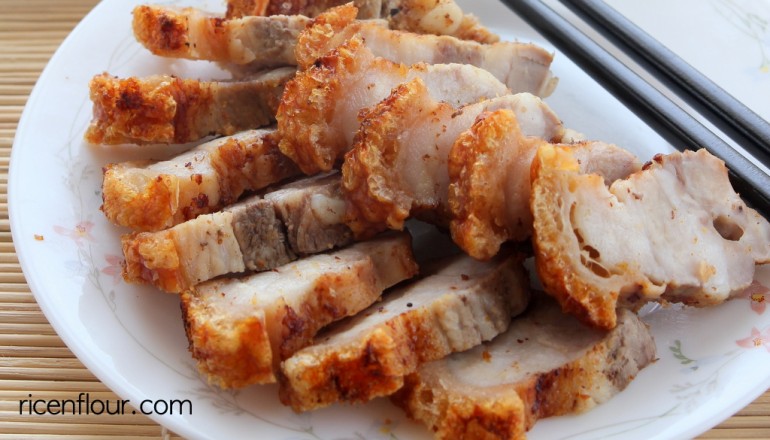Crispy roast pork is a very popular dish in Vietnam. It goes well with steamed rice, rice noodle (with sweet and sour dipping sauce), or tastes great just on its own. Making this dish at home is not too difficult. The biggest issue that concerns many home-cooks is probably how to make the skin crispy with perfect crackling. I have tried many different recipes before. Some ended with undercooked pork or burnt pork with super-hard skin and no crackling at all. Some other were quite fine but no recipe really made me feel 100% happy until I found out the one that I am going to share with you in this post.
This recipe was passed around on the social network in Vietnam for some weeks this Spring and received huuuggeee positive feedback from hundreds of thousands of people. Seeing all that, I gave it a try out of curiosity, and was instantly hooked. The method was so simple, no scoring the pork skin, no hassle wiping off the fat, yet the result is still outstanding: the crackling is golden brown and crunchy, while the meat remains juicy and tender. This method also involves producing steam in the oven, which is a neat tip to keep all the moist and juiciness inside the meat.
This roasting method is very easy with a high chance of success, but make sure you keep these few important points in mind before putting on that apron:
– The very essential secret of the perfectly crisp crackling lies in rubbing salt into the pork skin before roasting, but that is not enough. To make sure the skin cracks perfectly, the oven temperature must be high enough. I usually roast at 220 ~ 230°C (428 ~ 446°F), which is the commonly recommended cooking temperature range for pork, but make sure to roast it at a high rack, so that the pork skin stays close to the top heat element. This temperature is flexible depending on the kind of oven you use, so keep an eye on the pork as it roasts to make adjustments if needed. If the temperature is not high enough, the skin might fail to crack properly, and would become very rubbery (even having had salt rubbed on).
– It is highly recommended to use freshly boiled water when roasting the pork, as explained above. However, don’t submerge pork too much in water as the submerged part of the pork will taste like boiled pork or pork stew rather than roasted pork. In my case, I only used enough so that the pork is 1 – 2cm deep in water.
 CRISPY ROASTED PORK RECIPE
CRISPY ROASTED PORK RECIPE
Ingredients
- 0.5 kg (1 lb.) pork belly – choose a nice rectangle-shaped piece with a flat skin surface
- ½ tsp 5 spice powder
- ¼ tsp garlic powder (or 10 gram finely chopped garlic)
- ½ tsp onion powder (or 15 gram finely chopped shallots)
- ½ tsp salt
- Table salt to rub on skin – about 30 ~ 50 gram (2 – 3 tbsp)
Method
The video tutorial can be found on Savoury Days’ YouTube channel. If you cannot watch the video from this blog for some reasons, you can click on this direct link to YouTube. Don’t forget to turn on HD setting for the best quality.
1. Wash the pork thoroughly, then dry with paper towel. Mix together 5 spice powder, garlic powder, onion powder and salt, rub evenly all over the pork, including the skin. Cover and refrigerate for at least 2 hours, or overnight for the pork to absorb the seasoning.
* This seasoning is optional, but it helps make the pork a lot more flavorful. I’d say at least use onion powder to get rid of the somewhat unpleasant smell of pork.
2. Prepare a tray for roasting (I just used a large baking pan). Line the tray with aluminum foil or parchment paper to keep the tray as clean as possible, so that we won’t have to wash it after the first roasting.
3. Place seasoned pork into the tray with the skin side up. Gently pour table salt onto the skin so that the is completely covered with a layer of salt. Put oven on 230°C/ 446°F. Roast the pork for about 30 minutes in the middle of the oven. Note: If you season the pork with fresh garlic or shallots, make sure to wipe them all off to prevent them from burning and sticking to the pork.
* Boil a kettle of water.
4. After 25 ~ 30 minutes, the salt will harden and turn golden brown. Take the pork out from the oven, wipe this layer of salt completely off of the skin. Remove the lining foil or parchment paper. Place the pork back into the tray.
5. Raise the roasting rack to a higher shelf so that the skin stays closer to the top heat element. Place the tray back into the oven, pour some freshly boiled water into the tray so that the water level is about 1 – 2cm. Don’t use more than that, unless you prefer the looser texture like pork stew (as explained above). Continue roasting for 25 ~ 30 minutes at 220 ~ 230°C/ 428 ~ 446°F. Thanks to the salt and high temperature, the skin will crack beautifully during this second roasting step. In addition, the steam from boiled water prevents the pork from being burned too fast while maintaining the juiciness.
* The cooking time may vary depending on your oven (size, temperature stability…) and the thickness of the pork. If you use a small oven, you may need to lower the temperature and extend the cooking time. Thicker cuts require longer cooking time.
6. When the pork has completely cooked and the skin has fully cracked, take the pork out from the oven. Let cool for at least 15 minutes before slicing the pork into smaller servings. Don’t cut into it too soon, because the meat juice will escape from the meat, causing it to be drier.
Serve warm. This pork shouldn’t be left overnight, particularly in the fridge as the skin won’t be crispy anymore.
——————————–
- Recipe & Photos: Linh Trang
- Written and edited by: Holly Phuong Le




Amazing recipe, I tried it and it worked a treat! Thank you very much!